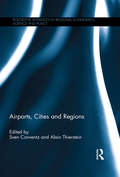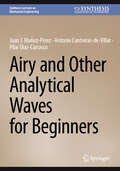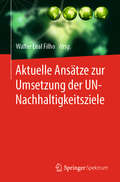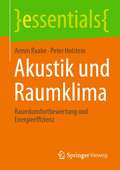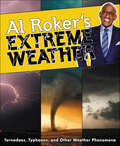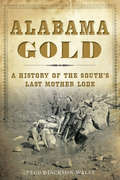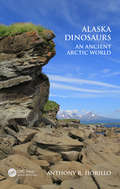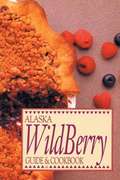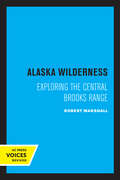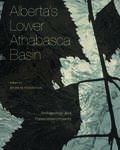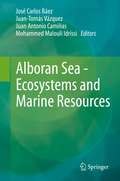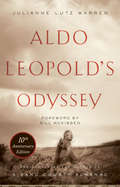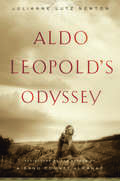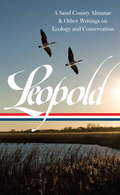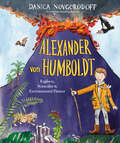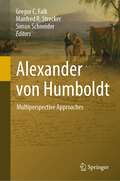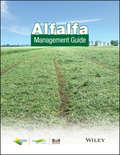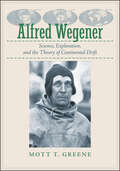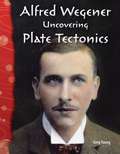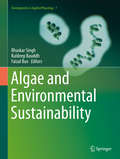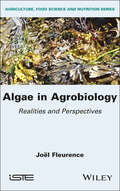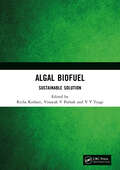- Table View
- List View
Airports, Cities and Regions (Routledge Advances in Regional Economics, Science and Policy)
by Sven Conventz Alain ThiersteinSince the emergence of urban systems, cities have developed in a mutually inter-dependent process of socio-economic dynamics and transportation linkages. In recent years, Airports worldwide have stepped beyond the stage of being pure infrastructure facilities while the complex dynamics that are taking place at and around international airports represent a crucial element in the post-industrial reorganisation of urban and regional systems. Airports are increasingly recognized as general urban activity centres; that is, key assets for cities and regions as economic generators and catalysts of investment in addition to being critical components of efficient city infrastructure. This book brings together contributions from renowned academic scholars and world leading practitioners to discuss insights gained from theory and practice. The first collection of papers reflects upon the general role and future of airports as well as their specific contribution to competitive advantages within a fast changing business and economic landscape. The second group of contributions ask about the role airports play within the innovation process that is inherently centred on generating and sharing knowledge. The third section of papers investigates the drivers of real estate developments on airport land and in the close vicinity of airports.
Airy and Other Analytical Waves for Beginners (Synthesis Lectures on Mechanical Engineering)
by Juan J. Muñoz-Perez Antonio Contreras-de-Villar Pilar Diaz-CarrascoThe aim of this book is to become something practical, providing a description of the essential theory (explained simply) and many solved exercises. The basic concepts necessary to understand the rudiments of the Airy wave and other analytical waves (and their application to Coastal Engineering) are clarified. Moreover, the appropriate mathematical tools are given in certain cases because some science courses do not require a minimum background in mathematics or physics. Despite not going into depth into the theoretical developments, experience has demonstrated that students are ensured to acquire the bare minimum of knowledge necessary to pursue any subsequent improvement course.
Aktuelle Ansätze zur Umsetzung der UN-Nachhaltigkeitsziele
by Walter Leal FilhoDas Buch befasst sich mit den Themen Nachhaltigkeit und Nachhaltigkeitsziele der UN. Obwohl letztere schon 2015 verabschiedet wurden und die Umsetzung bis 2030 abgeschlossen sein soll, herrscht gegenwärtig noch immer ein Mangel an Initiativen, die die Nachhaltigkeitsziele zum Thema haben. Das Buch stößt eine Diskussion darüber an, wie das Thema Nachhaltigkeit ganzheitlich in der Lehre, Forschung, Wirtschaft und Gesellschaft eingeführt und bearbeitet werden kann. Eine Vielzahl unterschiedlicher Disziplinen, von den Sozial- und Wirtschaftswissenschaften über Mode- und Kunst- sowie Umweltwissenschaften bis hin zu den Sprach- und Medienwissenschaften tragen zu dem Werk bei. Im Fokus des Buchs stehen die Mittel und Wege, mit denen das Engagement der Hochschulen und Nichtregierungsorganisationen in den globalen Bemühungen zur Umsetzung der Nachhaltigkeitsziele zusammengeführt wird. Der Band vereinigt viele Erfahrungen und Fallstudien, die zur Weiterentwicklung des Themas „Umsetzung der SDGs“ beitragen.
Akustik und Raumklima: Raumkomfortbewertung und Energieeffizienz (essentials)
by Armin Raabe Peter HolsteinObwohl in diesem essential akustische Messmethoden in Räumen und Gebäuden behandelt werden, ist hier Akustik nicht als Bauakustik zu verstehen. Zusätzlich zu herkömmlichen Methoden zur Bewertung des Innenraumklimas und für eine energieeffiziente Klimatisierung lassen sich mit akustischen Methoden Informationen gewinnen, die bei der Raumklimagestaltung von Nutzen sein können:- zur Analyse von Schallgeschwindigkeitsverteilungen als Informationsquelle über Temperatur- und Strömungsfelder in Räumen,- zur akustischen Detektion von Undichten zum Nachweis unerwünschter Be- bzw. Entlüftung und damit von Energieverlusten.Die Verfahren stammen zum Teil aus anderen Wissensgebieten, u.a. der Meteorologie, Tomografie oder der bildlichen Darstellung von Schallquellen. Damit können sie als Alternativen und Ergänzungen zu den herkömmlichen Methoden einer energieeffizienten Raumklimagestaltung verstanden werden.
Al Roker's Extreme Weather: Tornadoes, Typhoons, and Other Weather Phenomena
by Al RokerNew York Times bestselling author, award-winning meteorologist, and TodayShow co-anchor Al Roker explores extreme weather phenomena in his first book for kids. This middle grade book is an excellent choice for tween readers in grades 5 to 6, especially during homeschooling. It’s a fun way to keep your child entertained and engaged while not in the classroom. Dive deep into a world of fascinating weather with everyone’s favorite meteorologist, Al Roker!With this mesmerizing book that covers a wide range of topics, readers will learn about the conditions that generate unique weather occurrences like red sprites, thundersnow, and fogsicles.Surprising facts, colorful spreads, and captivating pictures will hook children and adults alike as they uncover the mysteries of extreme weather—some they never even knew existed!
Alabama Gold: A History of the South’s Last Mother Lode
by Peggy Jackson WallsGold rushes in Cleburne and Tallapoosa Counties attracted thousands of miners years before California's famous strike. In 1936, production at the Hog Mountain mine caused Alabama to be recognized as the top producer in the Appalachian states. In Hog Mountain's heyday, a local German settler discovered the precious metal while digging a wine cellar. In Log Pit, unscrupulous speculators "shot" ore into rock crevices and "salted" nuggets on land to enhance its sale value. A Cleburne County miner cleaned over eleven pounds of gold and was killed in a "free fight" all in one day. Join author Peggy Jackson Walls as she traces a century of gold mining in Alabama.
Alabama Grade 7 Prentice Hall Science Explorer
by Cyr Padilla MiaoulisLead author Michael Padilla once again sets the standard for engaging, hands-on science exploration. Correlates to Alabama state standards.
Alaska Dinosaurs: An Ancient Arctic World
by Anthony R. FiorilloAnthony Fiorillo has been exploring the Arctic since 1998. For him, like many others, the Arctic holds the romance of uncharted territory, extreme conditions, and the inevitable epic challenges that arise. For Fiorillo, however, the Arctic also holds the secrets of the history of life on Earth, and its fossils bring him back field season after field season in pursuit of improving human understanding of ancient history. His studies of the rocks and fossils of the Arctic shed light on a world that once was, and provide insight into what might be.
Alaska Wild Berry Guide And Cookbook
by Editors of Alaska MagazineA discription of and recipes for nearly 50 wild berries that grow in Alaska.
Alaska Wilderness: Exploring the Central Brooks Range, Second Edition
by Robert MarshallThis title is part of UC Press's Voices Revived program, which commemorates University of California Press’s mission to seek out and cultivate the brightest minds and give them voice, reach, and impact. Drawing on a backlist dating to 1893, Voices Revived makes high-quality, peer-reviewed scholarship accessible once again using print-on-demand technology. This title was originally published in 1970.
Alberta's Lower Athabasca Basin: Archaeology and Palaeoenvironments
by John W. Ives Alwynne B. Beaudoin Angela M. Younie Brian M. Ronaghan Brian O. Reeves Duane G. Froese Elizabeth C. Robertson Eugene M. Gryba Gloria J. Fedirchuk Grant M. Clarke James A. Burns Janet Blakey Jennifer C. Tischer Laura Roskowski Luc Bouchet Murray Lobb Nancy Saxberg Raymond J. Le Blanc Robert R. Young Robin J. Woywitka Stephen A. Wolfe Thomas V. Lowell Timothy G. FisherOver the past two decades, the oil sands region of northeastern Alberta has been the site of unprecedented levels of development. Alberta's Lower Athabasca Basin tells a fascinating story of how a catastrophic ice age flood left behind a unique landscape in the Lower Athabasca Basin, one that made deposits of bitumen available for surface mining. Less well known is the discovery that this flood also produced an environment that supported perhaps the most intensive use of boreal forest resources by prehistoric Native people yet recognized in Canada. Studies undertaken to meet the conservation requirements of the Alberta Historical Resources Act have yielded a rich and varied record of prehistoric habitation and activity in the oil sands area. Evidence from between 9,500 and 5,000 years ago—the result of several major excavations—has confirmed extensive human use of the region’s resources, while important contextual information provided by key geological and palaeoenvironmental studies has deepened our understanding of how the region’s early inhabitants interacted with the landscape. Touching on various elements of this rich environmental and archaeological record, the contributors to this volume use the evidence gained through research and compliance studies to offer new insights into human and natural history. They also examine the challenges of managing this irreplaceable heritage resource in the face of ongoing development. Contributors: Alwynne Beaudoin, Angela Younie, Brian O.K. Reeves, Duane Froese, Elizabeth Roberston, Eugene Gryba, Gloria Fedirchuk, Grant Clarke, John W. Ives, Janet Blakey, Jennifer Tischer, Jim Burns, Laura Roskowski, Luc Bouchet, Murray Lobb, Nancy Saxberg, Raymond LeBlanc, Robert R. Young, Robin Woywitka, Thomas V. Lowell, and Timothy Fisher
Alboran Sea - Ecosystems and Marine Resources
by José Carlos Báez Juan-Tomás Vázquez Juan Antonio Camiñas Mohammed Malouli IdrissiThe Alboran Sea represents a regional Mediterranean space where North and South worlds merges, creating a geopolitical region where marine resources and maritime activities should be managed from a national and international perspectives. It is widely known, that currently the planet is suffering a global change, and it is also affecting the Alboran Sea, its ecosystems and populations. An important first step to update a paramount vision on this region is to understand the climatic, geologic and oceanographic, including biochemical cycles, process which shapes the rich geodiversity, biodiversity, the productivity, and the sustainable use of the marine resources from Alboran Sea. The fisheries management system should take into account marine environmental variability to achieve biological sustainability of marine resources. Well-funded policy-makers’ decisions require a sound science based knowledge of the interaction between the marine environment and commercial stocks. This is because the role of marine environment in the evolution of fish stocks is sometimes even more important than the one played by fishers in the commercial exploitation of them. Finally, we should analyze the different aspects of political context that could affect the management of the resources from Alboran Sea in the context of climate change. This book reviews different aspects of the Alboran Sea to help understand the current situation from the original Tethis Ocean. The book is divided into four blocks: (i) Oceanographic, geological and ecological context (chapters 2 to 7), (ii) biodiversity and ecosystems distribution (chapters 8 to 12), (iii) fisheries resources and aquaculture (chapters 13 to 20), and (iv) conservation, management and marine polices (chapters 21 to 25).
Aldo Leopold's Odyssey, Tenth Anniversary Edition: Rediscovering the Author of A Sand County Almanac
by Julianne Lutz WarrenIn 2006, Julianne Lutz Warren(néeNewton) asked readers to rediscover one of history's most renowned conservationists. Aldo Leopold's Odyssey was hailed by The New York Times as a "biography of ideas," making "us feel the loss of what might have followed A Sand County Almanac by showing us in authoritative detail what led up to it. " Warren's astute narrative quickly became an essential part of the Leopold canon, introducing new readers to the father of wildlife ecology and offering a fresh perspective to even the most seasoned scholars. A decade later, as our very concept of wilderness is changing, Warren frames Leopold's work in the context of the Anthropocene. With a new preface and foreword by Bill McKibben, the book underscores the ever-growing importance of Leopold's ideas in an increasingly human-dominated landscape. Drawing on unpublished archives, Warren traces Leopold's quest to define and preserve land health. Leopold's journey took him from Iowa to Yale to the Southwest to Wisconsin, with fascinating stops along the way to probe the causes of early land settlement failures, contribute to the emerging science of ecology, and craft a new vision for land use. Leopold's life was dedicated to one fundamental dilemma: how can people live prosperously on the land and keep it healthy, too? For anyone compelled by this question, the Tenth Anniversary Edition of Aldo Leopold's Odyssey offers insight and inspiration.
Aldo Leopold's Odyssey: Rediscovering the Author of A Sand County Almanac
by Julianne Lutz NewtonA household icon of the environmental movement, Aldo Leopold (1887-1948) may be the most quoted conservationist in history. A Sand County Almanac has sold millions of copies and Leopold's writings are venerated for their perceptions about land and how people might live in concert with the whole community of life. But who is the man behind the words? How did he arrive at his profound and poetic insights, inspiring generations of environmentalists? Building on past scholarship and a fresh study of Leopold's unpublished archival materials, Julianne Lutz Newton retraces the intellectual journey generated by such passion and intelligence. Aldo Leopold's Odyssey illuminates his lifelong quest for answers to a fundamental issue: how can people live prosperously on the land and keep it healthy, too? Leopold's journey took him from Iowa to Yale to the Southwest to Wisconsin, with fascinating stops along the way to probe the causes of early land settlement failures, contribute to the emerging science of ecology, and craft a new vision for land use. More than a biography, this articulate volume is a guide to one man's intellectual growth, and an inspirational resource for anyone pondering the relationships between people and the land.
Aldo Leopold: A Sand County Almanac & Other Writings on Conservation and Ecology
by Aldo Leopold Curt MeineSince his death in 1948, Aldo Leopold has been increasingly recognized as one of the indispensable figures of American environmentalism. A pioneering forester, sportsman, wildlife manager, and ecologist, he was also a gifted writer whose farsighted land ethic is proving increasingly relevant in our own time. Now, Leopold's essential contributions to our literature--some hard-to-find or previously unpublished--are gathered in a single volume for the first time. Here is his classic A Sand County Almanac, hailed--with Thoreau's Walden and Carson's Silent Spring--as one of the main literary influences on the modern environmental movement. Published in 1949, it is still astonishing today: a vivid, firsthand, philosophical tour de force. Along with Sand County are more than fifty articles, essays, and lectures exploring the new complexities of ecological science and what we would now call environmental ethics. Leopold's sharp-eyed, often humorous journals are illustrated here for the first time with his original photographs, drawings, and maps. Also unique to this collection is a selection of over 100 letters, most of them never before published, tracing his personal and professional evolution and his efforts to foster in others the love and sense of responsibility he felt for the land.
Alexander von Humboldt: Explorer, Naturalist & Environmental Pioneer
by Danica NovgorodoffBudding botanists, growing geologists, and early explorers will dive into this picture book biography about the father of ecology, Alexander von Humboldt. The captivating prose and art from a New York Times bestselling illustrator will spark a passion for discovery and conservation in the youngest readers.Whether sailing across the ocean, hiking through the jungle, or climbing the highest volcanic peaks, everywhere Alexander went, he observed the land, animals, and culture. And where others saw differences, Alexander spotted connections. Discover the incredible life of naturalist Alexander von Humboldt, whose explorations created the basis for modern ecology, whose travels made him one of the most famous scientists of his day, and whose curiosities have inspired generations of creative thinkers.
Alexander von Humboldt: Multiperspective Approaches
by Gregor C. Falk Manfred R. Strecker Simon SchneiderThis book aims to view and to understand Alexander von Humboldt from different perspectives and in varying disciplinary contexts. His contributions addressed numerous topics in the earth but also life sciences—spanning from geo-botany, climatology, paleontology, oceanography, mineralogy, resources, and hydrogeology to links between the environmental impact of humans, erosion, and climate change. From the very beginning, he paved the way for a modern, integrated earth system science approach to decipher, characterize, and model the different forcing factors and their feedback mechanisms. It becomes obvious that Humboldt’s holistic approach is far beyond simple description and empiric data collection. As documented and analyzed in the different texts of this volume, he combines observation and analysis with emotions and subjective perceptions in a very affectionate way. However, this publication does not intend to add another encyclopedic text compilation but to observe and critically analyze this unique personality´s relevance in a modern context, particularly in discussing environmental and social key issues in the twenty-first century.
Alfalfa Management Guide (ASA, CSSA, and SSSA Books #152)
by Dan Undersander Mark Renz Craig Sheaffer Glen Shewmaker Mark SulcLearn how to achieve top yields to maximize profits. This 2011 edition offers the latest information and strategies for alfalfa establishment, production, and harvest. Includes many color photos and charts.
Alfred Wegener: Science, Exploration, and the Theory of Continental Drift
by Mott T. GreeneA masterful biography of Alfred Wegener (1880–1930), the German scientist who discovered continental drift.Winner of the CHOICE Outstanding Academic Title of the Choice ACRLAlfred Wegener aimed to create a revolution in science which would rank with those of Nicolaus Copernicus and Charles Darwin. After completing his doctoral studies in astronomy at the University of Berlin, Wegener found himself drawn not to observatory science but to rugged fieldwork, which allowed him to cross into a variety of disciplines. The author of the theory of continental drift—the direct ancestor of the modern theory of plate tectonics and one of the key scientific concepts of the past century—Wegener also made major contributions to geology, geophysics, astronomy, geodesy, atmospheric physics, meteorology, and glaciology. Remarkably, he completed this pathbreaking work while grappling variously with financial difficulty, war, economic depression, scientific isolation, illness, and injury. He ultimately died of overexertion on a journey to probe the Greenland icecap and calculate its rate of drift. This landmark biography—the only complete account of the scientist’s fascinating life and work—is the culmination of more than twenty years of intensive research. In Alfred Wegener, Mott T. Greene places Wegener’s upbringing and theoretical advances in earth science in the context of his brilliantly eclectic career, bringing Wegener to life by analyzing his published scientific work, delving into all of his surviving letters and journals, and tracing both his passionate commitment to science and his thrilling experiences as a polar explorer, a military officer during World War I, and a world-record–setting balloonist. In the course of writing this book, Greene traveled to every place that Alfred Wegener lived and worked—to Berlin, rural Brandenburg, Marburg, Hamburg, and Heidelberg in Germany; to Innsbruck and Graz in Austria; and onto the Greenland icecap. He also pored over archives in Copenhagen, Munich, Marburg, Graz, and Bremerhaven, where the majority of Wegener’s surviving papers are found. Written with great immediacy and descriptive power, Alfred Wegener is a powerful portrait of the scientist who pioneered the modern concept of unified Earth science. The book should be of interest not only to earth scientists, students of polar travel and exploration, and historians but to all readers who are fascinated by the great minds of science.
Alfred Wegener: Uncovering Plate Tectonics: Earth and Space Science (Science Readers)
by Greg YoungIn this appealing biography, children will read about the fascinating life, theories, and discoveries of Alfred Wegener. From his time in Greenland studying meteorology with hot balloons to his theory of Pangea, readers will be eager to learn more about Wegener's contributions to science and the strides he took towards developing the study of plate tectonics. The easy-to-read text, accessible glossary, helpful index, and intriguing facts work in conjunction with the lively images and captivating lab activity to engage readers from beginning to end! <P><P>Lexile Measure: 630L
Algae and Environmental Sustainability (Developments in Applied Phycology #7)
by Faizal Bux Bhaskar Singh Kuldeep BauddhThis book presents the dynamic role of algae in a sustainable environment. Two major aspects, namely bioenergy and bioremediation, have been elaborated in various chapter contributed by scientists and teachers from different geographical areas throughout the world. Algal biofuels is an emerging area of equal interest to researchers, industries, and policy makers working or focusing on alternative (i. e. renewable) fuels. Algae have been an area of interest due to their wide range of applications. Over the last 5 decades, eukaryotic algae have been used in the aquaculture industry as feed for invertebrates, providing a rich source of antioxidants, dietary fiber, minerals and protein. More recently, there has been a focus on the use of algal biomass in the development of alternative fuels. The extraction of oil from algae has been widely explored as a much more viable feedstock than plant-based oils in large-scale fuel production. using algae as feedstock has the advantages that it doesn't require arable land and that wastewater can be used as a source of nutrients in their culture. The multifunctional approach of algae includes pollution remediation, carbon sequestration, biofuels production, and delivery of value-added products. However, there are still some obstacles that need to be overcome to make their use as potential feedstock for biofuels techno-economically feasible. In order to maintain the sustainability aspect of algal biofuels, various aspects have to be studied and critically analyzed to assess the long-term sustainability of algal derived biofuels. This book discusses the role of algae as a promising future feedstock for biofuels. They are known to sequester carbon in much larger amounts than plants and as such the book also describes their phycoremediation potential for conventional as well as emerging contaminants. It describes the role of anaerobic digestion in algal biorefineries; bioreactions and process parameters; biogas recovery and reuse. The role of algal biofilm based technology in wastewater treatment and transforming waste into bio-products is discussed, and remediation of sewage water through algae is assessed. The book also describes the production of biohydrogen, bio-oil, biodiesel; and the major bottlenecks in their usage. The emerging characterization techniques of these biofuels (bio-oil and biodiesel) are described, as are the decolorizing potential of algae and the genetic engineering techniques that could enhance the production of lipids in algae. Other aspects of the book include the role of remote sensing technology in the monitoring of algae and a life cycle assessment of algal biofuels.
Algae in Agrobiology: Realities and Perspectives
by Joel FleurenceAlgae, macroalgae and microalgae can be valuable biological resources in a new, more environmentally friendly form of agriculture known as agrobiology. Indeed, the biological properties associated with algae are frequently relevant for agricultural and zootechnical purposes. It is this aspect that is behind the current popularity of algae in the development of new agricultural practices that are related to plant and animal production, which are referred to as agrobiology. Algae in Agrobiology offers a current and forward-looking account of algae use: in agriculture and in the sector of land and marine animal production, as algal extracts and molecules in the form of fertilizers or biostimulants for crops with agronomic interest, and as algal compounds in the area of plant and animal health. This book is based on advances in biochemical and agronomic research in order to explain the conventional practices associated with the use of algae in agriculture and livestock breeding. These advances make it possible to establish possible uses for marine algal resources in the agriculture of the future.
Algal Biofuel: Sustainable Solution
by Richa Kothari V. V. Tyagi Vinayak V. PathakAlgal Biofuel: Sustainable Solution primarily focuses on the different aspects of bioenergy production using algal biomass as microalgae are considered the optimum feedstock for bioenergy production. The major aim is to thoroughly review the available bioenergy options, challenges in bioenergy production, availability of bioenergy feedstock, and biomass to bioenergy conversion process. This book also highlights the feasibility of lignocellulosic biomass, crop residues, and non-edible oil seeds for generation of different bioenergy products. It will be helpful for researchers and other stakeholders working in the area of bioenergy production for development of innovative concepts in emerging areas of bioenergy. Print edition not for sale in South Asia (India, Sri Lanka, Nepal, Bangladesh, Pakistan and Bhutan).
Algal Biorefinery: An Integrated Approach
by Debabrata DasThis book critically discusses different aspects of algal production systems and several of the drawbacks related to microalgal biomass production, namely, low biomass yield, and energy-consuming harvesting, dewatering, drying and extraction processes. These provide a background to the state-of-the-art technologies for algal cultivation, CO2 sequestration, and large-scale application of these systems. In order to tap the commercial potential of algae, a biorefinery concept has been proposed that could help to extract maximum benefits from algal biomass. This refinery concept promotes the harvesting of multiple products from the feedstock so as to make the process economically attractive. For the last few decades, algal biomass has been explored for use in various products such as fuel, agricultural crops, pigments and pharmaceuticals, as well as in bioremediation. To meet the huge demand, there has been a focus on large-scale production of algal biomass in closed or open photobioreactors. Different nutritional conditions for algal growth have been explored, such as photoautotrophic, heterotrophic, mixotrophic and oleaginous. This book is aimed at a wide audience, including undergraduates, postgraduates, academics, energy researchers, scientists in industry, energy specialists, policy makers and others who wish to understand algal biorefineries and also keep abreast of the latest developments.
Algal Biorefinery: Developments, Challenges and Opportunities (Routledge Studies in Bioenergy)
by Sonil Nanda Ajay K. Dalai Vaibhav V. Goud Venu Babu BorugaddaThis book enables readers to understand the theoretical aspects, key steps and scientific techniques with a detailed mechanism to produce biofuels from algae. Each chapter provides the latest developments and recent advancements starting from algal cultivation techniques to the production of value-added green fuels, chemicals and products with wide applications. The volume brings together a broad range of international and interdisciplinary experts, including chemical and biological engineers, biotechnologists, process engineers, environmentalists, pharmacists and nutritionists, to one platform to explore the beneficial aspects and challenges for an algal-based biorefinery. Chapters address cutting-edge issues surrounding algal cultivation, including genetic modification of algal strains, design and optimization of photobioreactors and open-pond systems, algal oil extraction techniques and algal-derived fuel products (biodiesel, bio-gasoline, jet fuels and bio-oil). Finally, the book considers the potential environmental impacts for establishing a sustainable algal biorefinery through lifecycle analysis, techno-economic assessment and supply chain management. This book will be an important resource for students, academics and professionals interested in algal cultivation, biofuels and agricultural engineering, and renewable energy and sustainable development more broadly.
